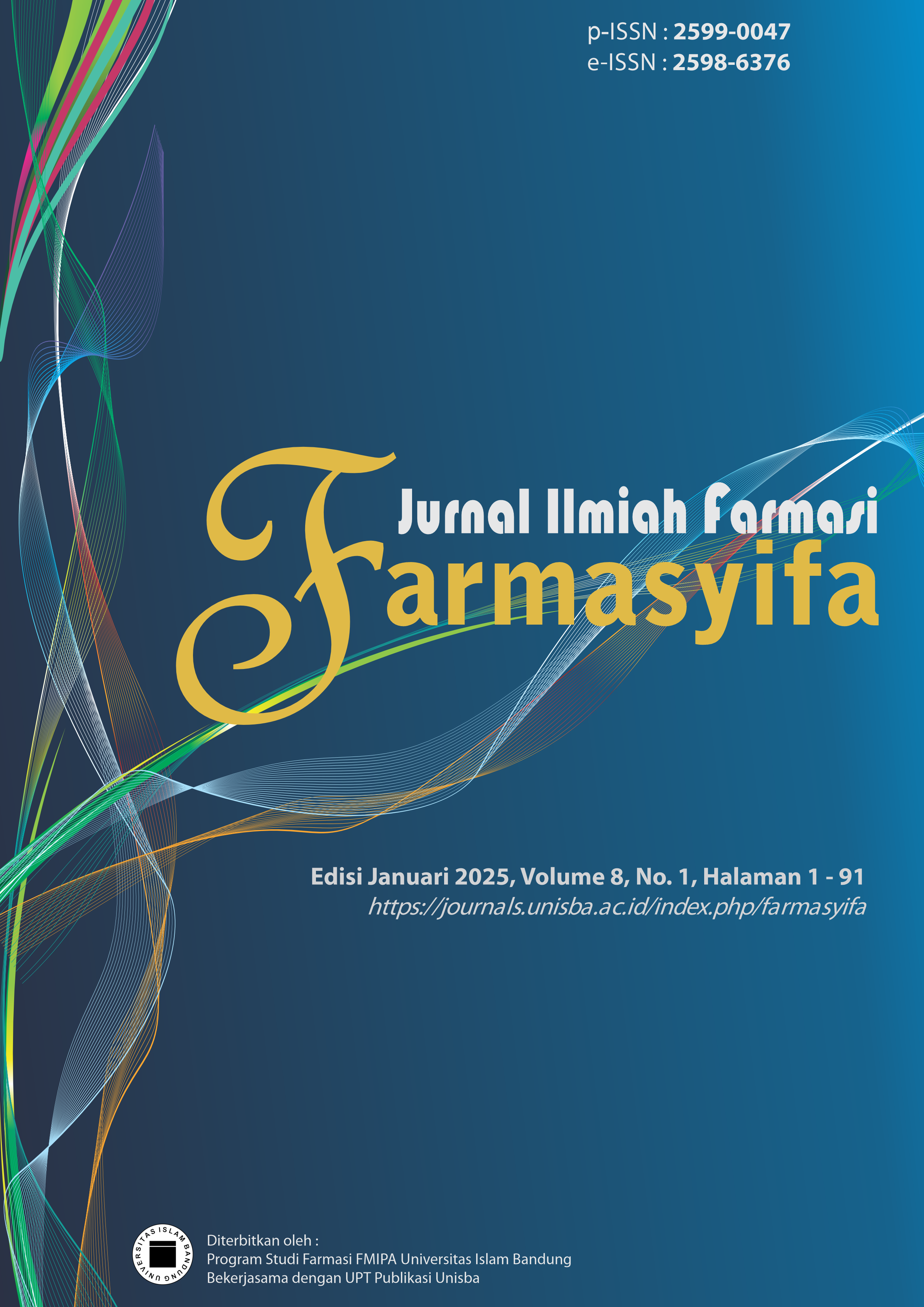Antioxidant Activity Test and Caffeine Level Determination in Green Tea Infusion with Variation of Brewing Time
UJI AKTIVITAS ANTIOKSIDAN DAN PENETAPAN KADAR KAFEIN PADA SEDUHAN TEH HIJAU DENGAN VARIASI WAKTU SEDUH
DOI:
https://doi.org/10.29313/jiff.v8i1.3962Keywords:
Antioxidant, Caffeine, Green Tea, Brewing TimeAbstract
Green tea is a type of non-fermented tea. The chemical compounds contained in tea have a good effect on health, including caffeine which is believed to reduce uric acid levels in the blood, and catechins as an antioxidant agent. People often consume green tea by brewing it without paying attention to the brewing time. The aim of this research was to determine caffeine levels and antioxidant activity in green tea brewing with varying brewing times. The brewing times used are 5, 10, 15, 20, 25 and 30 minutes. Determination of caffeine levels using the UV-Vis spectrophotometric method was measured at a wavelength of 275 nm. Determination of antioxidant activity using the DPPH (2,2-diphenyl-1-picrylhydrazyl) method with a UV-Vis spectrophotometer measured at a wavelength of 515.4 nm. Caffeine levels at brewing times of 5, 10, 15, 20, 20 and 30 minutes respectively were 64.20 ± 8.66 mg/g; 69.02±4.31 mg/g; 93.97±0.20 mg/g; 98.97±7.33 mg/g, 90.02±0.34 mg/g and 52.73±3.84 mg/g. The antioxidant test results are expressed in IC50 values respectively according to the length of brewing time, namely 91.32 ± 5.43 mg/L; 42.22±6.24 mg/L; 52.18±3.63 mg/L; 55.97±3.67 mg/L; 80.84±4.22 mg/L; 81.29±7.88 mg/L.
References
Bayani, F. (n.d.). Analisis Fenol Total Teh Hijau Komersial (Camellia sinensis L). 3(2), 318–323.
Chadijah, S., Musdalifah, M., Qaddafi, M., & Firnanelty, F. (2021). Optimalisasi Suhu dan Waktu Penyeduhan Daun Teh Hijau (Camellia sinensis L.) P+3 terhadap Kandungan Antioksidan Kafein, Katekin dan Tanin. In Bencoolen Journal of Pharmacy (Vol. 1, Issue 1, pp. 59–65).
Devi, D., Ulfin, I., Kimia, J., Matematika, F., Alam, P., & Kafein, A. (2015). Pengaruh Suhu dan Waktu Ekstraksi terhadap Kadar Kafein dalam Teh Hitam. 4(2), 105–108.
Dewi, T. O. A. (2019). UJI ANTIOKSIDAN SEDIAAN TEH CAMPURAN TEH HIJAU (Camellia sinensis), DAUN SIRSAK (Annona muricata L.) DAN DAUN PANDAN (Pandanus amaryllifolius Roxb.) SEBAGAI PERISA ALAMI Aptika. 2(2), 71–76.
Habibi, A. I., Firmansyah, R. A., & Setyawati, S. M. (2018). Indonesian Journal of Chemical Science Skrining Fitokimia Ekstrak n -Heksan Korteks Batang Salam (Syzygium polyanthum). 7(1), 1–4.
Karsidin, B., & Permatasari, D. (2020). Uji Aktivitas Antioksidan Krim Ekstrak Daun Teh Hijau (Camelia sinensis) dengan Metode DPPH (2,2-difenil-1-pikril hidrazil) Antioxidant Activity Test Green Tea Leaf Extract Cream (Camelia sinensis) with DPPH METHOD (2, 2-diphenyl-1-picril hydraz. 4(1).
Mukhtar, H., & Ahmad, N. (2000). Tea polyphenols :prevention of cancer and optimizing health 1 – 3. 71, 1698–1702.
Mutmainnah, N., Chadijah, S., & Qaddafi, M. (2018). PENENTUAN SUHU DAN WAKTU OPTIMUM PENYEDUHAN BATANG TEH HIJAU (Camelia Sinensis L.) TERHADAP KANDUNGAN ANTIOKSIDAN KAFEIN, TANIN DAN KATEKIN. Lantanida, 6(1), 1–11.
Najib, A., Malik, A., Ahmad, A. R., Handayani, V., Syarif, R. A., & Waris, R. (2017). STANDARISASI EKSTRAK AIR DAUN JATI BELANDA DAN TEH HIJAU. 4(2), 241–245.
Nasional, B. S. (2016). Standar Nasional Indonesia: Teh hijau.
Nikniaz, Z., Mahdavi, R., Ghaemmaghami, S. J., Yagin, N. L., & Nikniaz, L. (2016). Effect of different brewing times on antioxidant activity and polyphenol content of loosely packed and bagged black teas (Camellia sinensis L.). 6(3), 313–321.
Novilla, A., Djamhuri, D. S., Nurhayati, B., Rihibiha, D. D., Afifah, E., & Widowati, W. (2017). Anti-inflammatory properties of oolong tea (Camellia sinensis) ethanol extract and epigallocatechin gallate in LPS-induced RAW 264.7 cells. Asian Pacific Journal of Tropical Biomedicine, 7(11), 1005–1009. https://doi.org/10.1016/j.apjtb.2017.10.002
Pavithra, V. (2021). Review Article on Caffeine Activity. 3(1), 1–5.
Rastuti, U., & Purwati. (2012). UJI AKTIVITAS ANTIOKSIDAN EKSTRAK DAUN KALBA (Albizia falcataria) DENGAN METODE DPPH(1,1-Difenil-2-pikrilhidrazil) DAN IDENTIFIKASI SENYAWA METABOLIT SEKUNDERNYA. Molekul, 7(1), 33–42.
Ratnani, S., & Malik, S. (2022). Therapeutic Properties of Green Tea: A Review. Journal of Multidisciplinary Applied Natural Science, 2(2), 90–102. https://doi.org/10.47352/jmans.2774-3047.117
Rohdiana, D., & Al-ghifari, U. (2015). Teh : Proses, Karakteristik & Komponen Fungsionalnya. August.
Shrivastava, R. R., Pateriya, P., & Singh, M. (2018). Green Tea -A Short Review. Int J Ind Herbs Drugs, 3(2), 12–21. https://www.saap.org.in/journals/index.php/herbsanddrugs/article/view/70. Diakses tanggal 21 November 2022.
Suteerapataranon, S., Butsoongnern, J., Punturat, P., Jorpalit, W., & Thanomsilp, C. (2009). Caffeine in Chiang Rai tea infusions: Effects of tea variety, type, leaf form, and infusion conditions. Food Chemistry, 114(4), 1335–1338. https://doi.org/10.1016/j.foodchem.2008.11.013
Wardani, R. K., & Fernanda, M. A. H. F. (2016). Analisis Kadar Kafein Dari Serbuk Teh Hitam, Teh Hijau dan Teh Putih (Camellia sinensis L.). 1(1), 2015–2017
Downloads
Published
How to Cite
Issue
Section
License
Copyright (c) 2025 Aptika Oktaviana Trisna Dewi

This work is licensed under a Creative Commons Attribution-ShareAlike 4.0 International License.






















